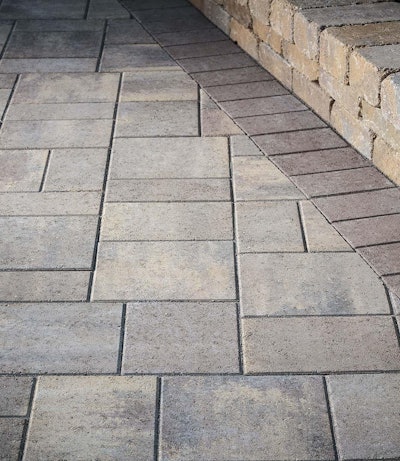 Photo: Titan Pavers
Photo: Titan PaversInterlocking concrete pavers are a staple of hardscaping projects nowadays, but prior to the mid-1940s, only individual cut stones or clay bricks could be used to create segmental paving for roadways and paths.
Holland created concrete pavers due to the fact it is under sea level and constantly had to deal with ground shifts causing infrastructure failures. Concrete pavers proved to be stronger and more economical than chipped stone or bricks.
These first concrete pavers had the same dimensions of a brick. Known as Holland stones, these original concrete pavers are still available today.
 Photo: Titan Pavers
Photo: Titan PaversIt wasn’t until 1973 that the first concrete pavers were produced in North America in Canada.
Since then, the usage of interlocking concrete pavers has skyrocketed and the pavers come in a variety of colors, shapes, sizes and textures.
“Interlocking pavers are best suited, in fact, for any type of hardscaping project,” says Max Nottingham, CEO of Titan Pavers, based in Los Angeles, California. “Whether it’s for a backyard patio, walkway, pool deck, driveway, etc., pavers are an excellent choice in terms of aesthetics, performance and longevity.”
Because there is such an abundance of options for homeowners to choose from when it comes to interlocking concrete pavers, Nottingham says it’s important for the project manager to ask questions, evaluate the homeowner’s needs and be knowledgeable in the field.
“Only then may they recommend a quality product from a well-established manufacturer that offers a good warranty and exceptional customer support,” he says.
One element that is crucial to ensure that a hardscaping project using interlocking concrete pavers will stand the test of time is for it to be installed properly.
Nottingham says landscapers should hire a licensed hardscape contractor who is certified by the Interlocking Concrete Pavement Institute (ICPI). The ICPI was created in 1993 and ensures that industry best practices are followed when it comes to the installation of segmental concrete pavement systems.
“The most common mistake that some landscapers make is to not follow the guidelines of ICPI,” Nottingham says. “Landscapers have been known to not excavate deep enough and/or use sub-base materials that are not durable enough. As a result, the pavers start sinking, or shifting, within a month or so of installation. It is imperative that homeowners use contractors that are ICPI certified in order to ensure proper installation of interlocking pavers.”
ICIP outlines the basics of an installing good interlocking concrete pavement system here but some of the main steps include.
- Site layout and excavation – the project site should be excavated to the subsoil. The depth can be calculated by adding the thickness of the paver, an inch of bedding sand and necessary gravel recommended for the type of project you are installing.
- Preparing the soil subgrade – 70 percent of the labor should be spent on the soil subgrade and base preparation.
- Soil compaction – Compaction on the soil subgrade increases the soil’s load bearing strength, prevents pavement settling, seasonal movement and ensures any movement is uniform.
- Soil grading – to ensure proper drainage, the paved area should slope away from the house by at least 2 percent.
- Bedding sand – bedding sand is spread evenly over the base and screed to a nominal 1-inch thickness.
- Paver compaction and joint sand – pavers should be compacted first without joint sand to create initial interlock and then joint sand is spread and swept in until the joins are full.
The usage of the hardscaping space will determine if there are different standards for the installation. For instance, driveway installations are slightly different in that they require more excavation and more subbase to withstand the weight of a vehicle, according to Nottingham.
Concrete pavers have multiple benefits including their durability, low maintenance, aesthetics and safety.
Industry specifications require pavers to meet a minimum average compressive strength of 8,000 psi making it considerable stronger than poured in place concrete, which has strength ranging from 1,500 – 2,500 psi.
 Photo: Titan Pavers
Photo: Titan Pavers“Pavers are very durable; they can withstand the weight of vehicles without cracking, breaking or becoming damaged,” Nottingham says. “However, in the rare event cracks do appear, the pavers can be easily individually replaced.”
Because these pavers are so durable, there is rarely any need for maintenance. Sealing is an option to enhance colors and prevent staining.
Thanks to the customizable nature of concrete pavers customers can select patterns that complement the architectural style of their home and fit any aesthetic without the price of using natural stone.
The pavers also provide a skid and slip resistant surface for those concerned about safety.
Nottingham says there are no drawbacks with installing concrete pavers in terms of durability and longevity.
“Concrete pavers take a bit longer to install and can be slightly more expensive than grey concrete due to quality of product and need for meticulous and precise installation,” he says.











